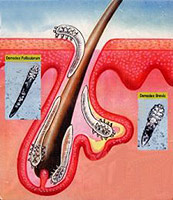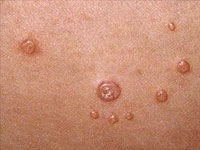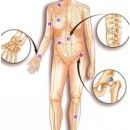What is the demodecosis of the eyelids? What are the causes of the demodecosis of the eyelids? How diagnostics is carried out? How is the treatment of demodecosis? Answers to these questions you will find in the article.
Content
Symptoms of demodecosis of the eyelid
Favorite Localization Tick - eyelids, leather facial, domain domain, forehead, nasolabial folds, chin, outer hearing pass. Products of ticks contribute to body allergization, cause specific eye lesions - demodic blufarite and blophies.
The main manifestation of demodicosis is redness of the edges of the eyelids, peeling of the eyelids, loss of eyelashes, thinning of eyelashes, eye fatigue. In the initial stage, patients complain of a permanent, sometimes unbearable itching, especially after sleep. In the afternoon worried about the feeling of cutting, caustic sticky disconnected, irresistible desire to scratch, wipe the eyes. Scalys appear in the eyelashes, the mucous membrane accumulates along the edge of the age, forming yellowish crusts. History: frequent stamps, eyelashes loss, recurrent acne rash. Washing facial tonic and soap causes itching and burning. Moisturizing creams can lead to the exacerbation of the process, staying in artificial salarial, in the sun.
The disease is chronic in nature with seasonal exacerbations in spring and autumn.
Causes of demodicosis of the eyelid

For the development of demodecosis, the presence of an excitator alone is not enough. As mentioned above, this tick is present on the skin in very many people (conditionally pathogenic microorganism), but causes the disease far from all of them. The main cause of intensive reproduction of ticks is to reduce immunity, which in turn may be due to many reasons. Thus, the occurrence or exacerbation of the demodicosis can occur in chronic diseases of the gastrointestinal tract, with the disease of the endocrine system, hepatitis, metabolic disorders, non-refractive refractive pathology (hyperopia, myopia), in persons with fatty porous skin, in seboro. Also, the decrease in the protective properties of the skin occurs during long-term use of ointments containing glucocorticoids (prednisone, hydrocortisone, etc.), during pregnancy, constant mental tension, alcohol consumption, etc.
How to diagnose the demodecosis of the eyelids
Diagnosis of demodecosis is quite simple. The diagnosis is usually put on the basis of an ophthalmic inspection, identifying signs of the disease, as well as using a microscopic study. From the upper and lower eyelid of each eye with a special tweezers take eyelashes, they are placed on the glass slide and are considered by the microscope. Such a study makes it possible to quickly diagnose and prescribe treatment. Usually this study is carried out at any suspected demodecosis.
How is the treatment of demodecosis
The complexity of the fight against the subcutaneous tick is determined by the fact that it is our symbiotic (Individual participant of symbiosis), that is, its presence is the norm, and not pathology. However, these ticks bring only when they begin to breed violently. If this disease occurred, then it is almost impossible to fully cure it, t. To. It is necessary to eliminate the cause of tick reproduction. As a rule, in the treatment of demodex, they try to remove the aggravation of the disease and achieve more or less long-term remission. At the same time, special medicines that only a doctor will appoint you. In addition, it is necessary to stick to the diet, in particular, exclude acute and salty food from the diet. Solar irradiation should be avoided.
Simultaneously with the treatment, the disinsection of bed and native linen (T.To. There is a possibility of infecting those surrounding through contacts with personal items and hygiene objects; repeat self-effects). Creams containing honey negatively affect the vasodilatory procedures, especially the bath.
If you suspect the presence of Demodex you need to urgently undergo a survey and consult with an ophthalmologist. The delay of treatment may entail rather complex eye diseases, and in some cases irreversible consequences: ulcerative blepharitis followed by scarring. Keep in mind that this disease may, with long flow in some cases, accompanied by a more dangerous defeat of the eyes itself.









